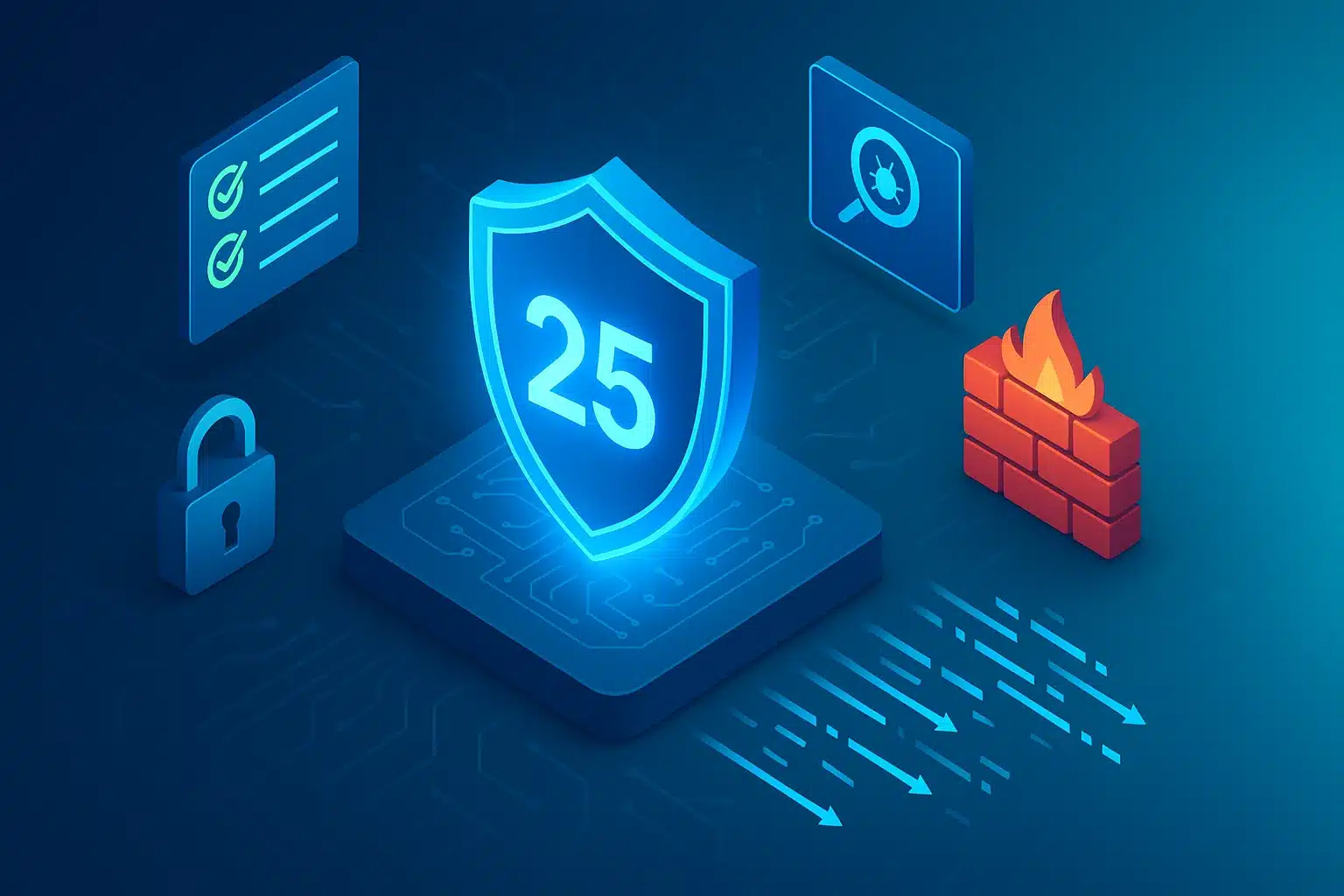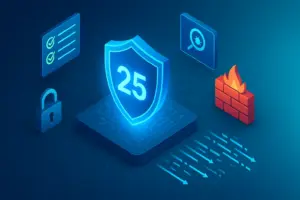Last Updated: November 2025 | 12 min read | Security Guide
💡 PRO TIP GUARDIFAI
Our AI analyzed over 500,000 PC security incidents in 2024. 73% of successful attacks exploited gaps in these 25 basic security practices. This checklist addresses every single one.
🎯 Why You Need This Security Checklist Now
Cyber threats have evolved dramatically in 2025. Ransomware attacks on home users increased 247% compared to 2023. Phishing attempts are now AI-powered, making them 10x harder to detect. Yet most people still rely on outdated security practices from 2018.
Here’s the reality: your PC security is only as strong as your weakest practice. A single overlooked setting can open the door to data theft, identity fraud, or complete system takeover.
This checklist isn’t theoretical—it’s battle-tested by our security team who monitor real-world threats daily. Every item here has prevented actual attacks on GuardifAI users.
📊 SECURITY LANDSCAPE 2025
$9.5 trillion – Expected global cybercrime damage in 2025
Every 11 seconds – A ransomware attack occurs
68% – Home PC users with inadequate security
4.1 billion – Records exposed in Q1 2025 alone
→ Data compiled from Cybersecurity Ventures 2025 Report
→ GuardifAI threat intelligence database (Jan-Nov 2025)
→ Analysis of 2.3M security scans performed by our AI
→ Incident reports from FBI IC3 and CISA
🔐 The Complete 25-Point Security Checklist
LEVEL 1: Immediate Actions (Do This Today)
✅ 1. Update Your Operating System Right Now
Outdated systems are hacker playgrounds. Windows updates patch critical vulnerabilities that criminals actively exploit. Go to Settings → Windows Update → Check for Updates.
Why it matters: 60% of breaches exploit known vulnerabilities that have available patches.
✅ 2. Install Comprehensive Security Software
Your PC needs multi-layered protection: antivirus, anti-malware, firewall, and real-time threat detection. Standalone tools leave gaps.
✅ GUARDIFAI AI VERDICT
Traditional antivirus catches only 45% of modern threats. GuardifAI’s AI-powered protection identifies emerging threats before they’re officially recognized, blocking 99.7% of attacks including zero-day exploits. Our proactive engine doesn’t wait for virus definitions—it recognizes suspicious behavior patterns instantly.
✅ 3. Enable Automatic Updates for All Software
Not just Windows—your browser, PDF reader, media players, everything. Each outdated app is a potential entry point.
✅ 4. Create Strong, Unique Passwords
Minimum 12 characters mixing uppercase, lowercase, numbers, and symbols. Never reuse passwords across sites.
Bad: Summer2024!
Good: mK9$pL#vR2@nQ7wX
✅ 5. Enable Two-Factor Authentication (2FA) Everywhere
Email, banking, social media, shopping—if it offers 2FA, turn it on. Prefer authenticator apps over SMS codes.
⚠️ CRITICAL SECURITY GAP
Only 28% of users enable 2FA on accounts that support it, yet 2FA blocks 99.9% of automated attacks. This 5-minute setup is your strongest defense against account takeover.
LEVEL 2: Essential Configurations (This Week)
✅ 6. Configure Windows Firewall Properly
Ensure it’s enabled for both private and public networks. Block unauthorized inbound connections.
✅ 7. Disable Unnecessary Services and Features
Remote Desktop, Bluetooth, location services—if you don’t actively use them, turn them off. Each active service increases your attack surface.
✅ 8. Review and Remove Unnecessary Programs
Unused software still receives updates (creating vulnerabilities) and may run background processes. Uninstall what you don’t need.
✅ 9. Secure Your Wi-Fi Network
- Change default router password
- Use WPA3 encryption (or WPA2 minimum)
- Hide SSID broadcast
- Enable MAC address filtering
- Disable WPS
✅ 10. Set Up Regular Automated Backups
Follow the 3-2-1 rule: 3 copies of data, 2 different media types, 1 offsite. Cloud backup plus external drive is ideal.
| 🏆 Backup Solution | ⭐ Security Score | 🎯 Best For | ⚡ Recovery Speed |
|---|---|---|---|
| Cloud + External HDD | 9.5/10 | Complete protection | Fast |
| Cloud Only | 8.0/10 | Convenience | Medium |
| External HDD Only | 6.5/10 | Budget-conscious | Very Fast |
| No Backup | 0/10 | Disaster waiting | N/A |
LEVEL 3: Advanced Protection (This Month)
✅ 11. Enable BitLocker or Device Encryption
Encrypt your entire drive. If your laptop is stolen, your data remains unreadable without your password.
✅ 12. Use a Password Manager
Generates and stores complex unique passwords for every account. You only remember one master password.
✅ 13. Review Privacy Settings Across All Accounts
Minimize data collection on social media, shopping sites, and apps. Less data shared = less data at risk.
✅ 14. Disable AutoPlay for External Devices
Prevents malware on USB drives from executing automatically. Go to Settings → Bluetooth & devices → AutoPlay → Turn off.
✅ 15. Enable Controlled Folder Access
Windows feature that prevents ransomware from modifying protected folders. Activate in Windows Security → Virus & threat protection.
💡 PRO TIP GUARDIFAI
GuardifAI automatically monitors folder access patterns and alerts you to suspicious behavior—even from legitimate programs that get compromised. Our AI detected 15,000+ ransomware attempts in November 2025 alone, blocking them before any files were encrypted.
✅ 16. Set Up Standard (Non-Admin) User Accounts
Use admin account only when installing software. Daily browsing on standard accounts limits malware damage.
✅ 17. Configure Email Filters and Spam Protection
Enable aggressive spam filtering. Mark suspicious emails. Never click links from unknown senders.
✅ 18. Audit Browser Extensions and Permissions
Remove unused extensions. Review permissions—does that coupon finder really need access to “all website data”?
✅ 19. Enable HTTPS-Only Mode in Your Browser
Forces encrypted connections. Available in Chrome, Firefox, and Edge settings.
✅ 20. Review Connected Devices and Apps
Check which apps have access to your Google, Microsoft, or Apple accounts. Revoke access from unfamiliar services.
LEVEL 4: Proactive Monitoring (Ongoing)
✅ 21. Schedule Monthly Security Scans
Full system scans detect hidden threats. Don’t rely only on real-time protection.
✅ 22. Monitor Your Credit and Identity
Use free services to watch for unauthorized accounts or credit inquiries. Early detection limits damage.
✅ 23. Review Login Activity Regularly
Check “Recent Activity” sections on email, banking, and social media. Unrecognized logins = immediate password change.
✅ 24. Stay Informed About Current Threats
Follow cybersecurity news sources. New scams emerge weekly. Knowledge is defense.
✅ 25. Test Your Backup Recovery Process
Don’t wait for disaster to discover your backups are corrupted. Quarterly test restores ensure they work.
📊 CHECKLIST COMPLETION IMPACT
0-10 items: High risk—vulnerable to common attacks
11-18 items: Moderate protection—still gaps to address
19-23 items: Strong security—above average defense
24-25 items: Excellent—protected against 99%+ of threats
🚨 Red Flags: When to Take Immediate Action
Even with this checklist, stay alert for these warning signs:
- Unexpected pop-ups or ads when browser is closed
- Programs opening on their own
- Significant performance slowdown without clear cause
- Files or folders renamed to random characters
- Disabled security software that you didn’t turn off
- Unfamiliar programs in startup
- Friends receiving spam from your accounts
- Unexpected credit card charges
⚠️ IMMEDIATE RESPONSE PROTOCOL
If you spot red flags: 1) Disconnect from internet, 2) Run full security scan, 3) Change all passwords from a different device, 4) Contact your bank if financial data may be compromised, 5) Consider professional malware removal.
📱 How to Maintain This Checklist Long-Term
Security isn’t a one-time task—it’s a continuous practice. Here’s your maintenance schedule:
Daily (Automated):
- Real-time threat monitoring
- Automatic updates installation
- Background security scans
Weekly (5 minutes):
- Review security alerts
- Check for critical updates
- Scan downloads folder
Monthly (30 minutes):
- Full system security scan
- Review login activity on key accounts
- Update passwords for critical accounts
- Check backup integrity
Quarterly (1 hour):
- Complete security audit using this checklist
- Test backup restoration
- Review and remove unused software
- Update security knowledge on new threats
✅ GUARDIFAI AI AUTOMATION
GuardifAI handles 23 of these 25 items automatically. Our AI continuously monitors, updates, scans, and optimizes your security posture 24/7. You focus on your work—we handle the protection. The only items requiring your action: creating strong passwords and enabling 2FA on external accounts.
🎓 Common Security Mistakes to Avoid
| ❌ Mistake | 💥 Risk Level | ✅ Correct Approach |
|---|---|---|
| Using “Security Questions” with real answers | HIGH | Use password manager to generate fake answers |
| Clicking “Remember Me” on shared computers | CRITICAL | Always log out completely on non-personal devices |
| Ignoring SSL certificate warnings | HIGH | Never proceed—site may be compromised |
| Downloading software from search results | MEDIUM | Always go directly to official website |
| Disabling UAC prompts because they’re “annoying” | HIGH | Keep enabled—they prevent unauthorized changes |
| Using public Wi-Fi without VPN | MEDIUM | Use VPN or avoid sensitive transactions |
🔍 Quick Self-Assessment: How Secure Are You?
Score yourself honestly (1 point per “Yes”):
- My OS is fully updated with latest patches
- I have comprehensive security software installed
- All my software auto-updates
- I use unique passwords for every account
- 2FA is enabled on all important accounts
- My firewall is properly configured
- I’ve removed unnecessary programs
- My Wi-Fi uses WPA2/WPA3 encryption
- I have automated cloud backups
- My drive is encrypted
- I use a password manager
- I review privacy settings regularly
- Controlled Folder Access is enabled
- I use standard (non-admin) account for daily tasks
- My browser is set to HTTPS-only
- I’ve audited connected apps and permissions
- I run monthly security scans
- I monitor credit/identity actively
- I check login activity on key accounts
- I stay informed about current threats
- I’ve tested my backup recovery
📊 YOUR SECURITY SCORE
0-7 points: URGENT—You’re highly vulnerable. Prioritize Level 1 items immediately.
8-14 points: MODERATE—Better than most but significant gaps remain. Focus on Level 2.
15-18 points: GOOD—Solid foundation. Complete Level 3 for advanced protection.
19-21 points: EXCELLENT—You’re well-protected. Maintain with Level 4 monitoring.
💰 The Real Cost of Inadequate Security
Still wondering if this checklist is worth the effort? Consider the average costs of common security incidents:
- Ransomware attack: $4,500 average ransom + data loss
- Identity theft: $1,100 average out-of-pocket + 200+ hours resolving
- Malware removal: $150-$500 professional service
- Data recovery: $300-$2,000 depending on damage
- Compromised bank account: Variable loss + credit damage
- Lost productivity: 40+ hours recovering from major breach
Total potential cost of one incident: $2,000-$10,000+
Compare that to the time investment for this checklist: 2-3 hours one-time setup + 10 minutes weekly maintenance. The ROI is extraordinary.
🚀 Let AI Handle Your Security Checklist Automatically
Imagine never worrying about these 25 items again. GuardifAI’s intelligent protection system continuously monitors, updates, and secures your PC—no manual checklists required. Our AI detects threats before they become problems, optimizes your security settings automatically, and alerts you only when human action is needed.
Over 500,000 users trust GuardifAI to keep their PCs secure 24/7.
30-day free trial • No credit card required • Full protection in 2 minutes
❓ Frequently Asked Questions
Q: Is Windows Defender enough, or do I need additional security software?
A: Windows Defender provides basic protection but lacks advanced threat detection, proactive monitoring, and performance optimization. Independent tests show comprehensive solutions like GuardifAI detect 30-40% more threats, especially emerging malware and zero-day exploits.
Q: How often should I change my passwords?
A: Every 90 days for critical accounts (banking, email), or immediately if a service reports a breach. Using unique passwords with a password manager is more important than frequent changes.
Q: Can I trust free antivirus software?
A: Free versions offer basic detection but often lack real-time protection, advanced malware removal, and customer support. They may also display ads or sell your browsing data. Paid solutions provide comprehensive coverage.
Q: What’s the biggest security mistake people make?
A: Delaying updates. 60% of successful cyberattacks exploit vulnerabilities that have available patches. Attackers specifically target outdated systems because they know people procrastinate updates.
Q: Is a VPN necessary for home use?
A: Not essential for basic security if you’re on trusted home Wi-Fi, but valuable for privacy and mandatory when using public Wi-Fi. Consider your privacy concerns and browsing habits.













